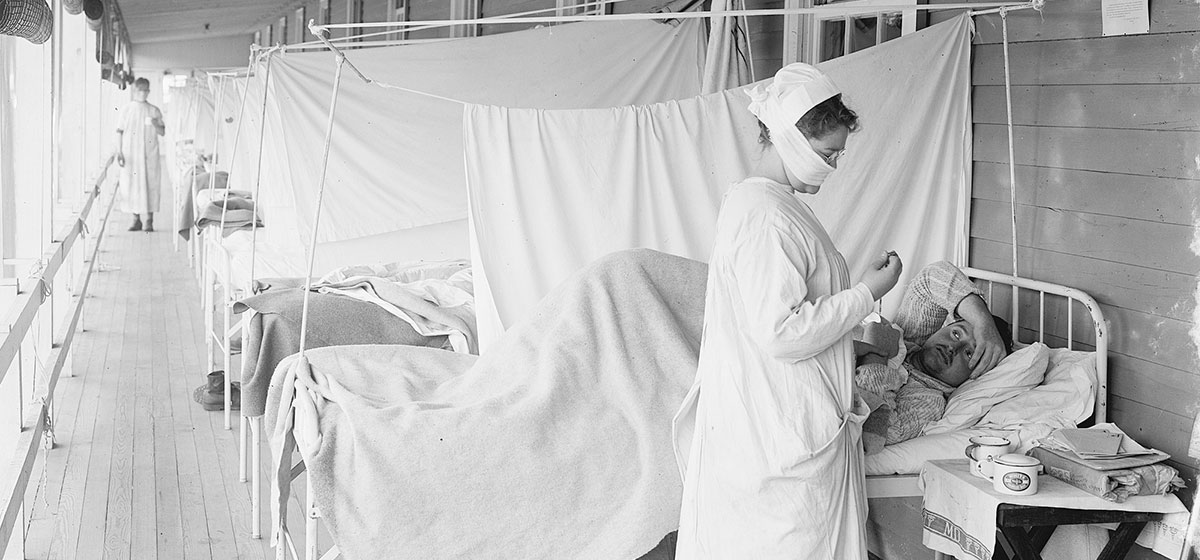When the Spanish Flu Swept In, Pittsburgh Failed the Test

Within days of Allegheny County’s first confirmed case of coronavirus in March, city and county officials moved to shutter nonessential businesses, with their efforts buttressed by stay at home orders from Harrisburg shortly thereafter.
This was not the case in 1918, when the Spanish flu ravaged the region, state, nation and world. And Pittsburghers paid a high price.
The city suffered the highest per capita death rate in the nation, a fact that many historians blame on local leaders’ reluctance to shut down the economy and a longstanding apathy toward the health of the general population.
Pittsburgh’s first official cases of the Spanish Flu were recorded on October 2, 1918 in the makeshift military barracks on the campuses of the University of Pittsburgh and the Carnegie Technical Institute.
“On this day two men were found with the disease and were isolated,” according to “Studies on Epidemic Influenza comprising Clinical and Laboratory Investigations,” a study of the pandemic released by the University of Pittsburgh School of Medicine in 1919. “On the following day there were four, and on the third day eight.”
By that point, cases of the virus had been spreading throughout the United States and Europe for several months.
The spring of 1918 saw dozens of reported cases of a new and mysterious form of influenza from Kansas City to the Western Front of World War I, but the full scale of the threat was not apparent until the fall, when major American cities began to report massive spikes in infections.
By the time Pittsburgh had its first patients in early October, Seattle had 700 reported cases, Philadelphia’s hospitals were overrun and Boston’s death toll had reached 202.
While other cities had more overall deaths from the disease, Pittsburgh’s mortality rate topped every city in the nation. After 24 weeks of pandemic, Boston reported a rate of 710 death per 100,000 residents and Philadelphia reported 784.
Pittsburgh reported 807 per 100,000 residents.
Communities across the world struggled to contain the virus amid a lack of healthcare infrastructure and a dearth of medical knowledge. But Pittsburgh’s outbreak was made significantly worse by decades of corrupt and short-sighted public policy combined with a shambling, haphazard response from the local government.
Pittsburgh’s public health was in crisis well before the pandemic, according to James Higgins, a history professor at the University of Houston, who studies Pittsburgh’s response to the pandemic.
“Between 1900 and 1902, Pittsburgh recorded 253 deaths per 100,000 from pneumonia,
behind only New York, while the years 1912 through 1914 saw the death rate for pneumonia rise to 261 per 100,000, the worst rate in the nation,” Higgins reports in “With Every Accompaniment of Ravage and Agony: Pittsburgh and the Influenza Epidemic of 1918–1919.”
“Pittsburgh’s horrendous air quality, the result of coke production and the burning of bituminous coal, was an important environmental factor that contributed to the severity of the illness in Pittsburgh’s residents. The business community thwarted attempts to pass or enforce smoke abatement in Pittsburgh because of the added expense such measures entailed and because, philosophically, they resented governmental encroachment on private-property prerogatives.”
The director of the City’s Board of Health was William H. Davis, described as a “party stalwart with no medical background,” who was also a high-ranking member of the chamber of commerce. The board itself was “a hollow municipal organ composed of political appointees,” which did not produce a single annual report from 1912 to 1919.
Compounding these chronic institutional and environmental issues was the state of the region’s healthcare system. The further communities were from the city, the fewer doctors they had, if any. The city’s large black and immigrant populations were confined to densely populated and chronically underserved neighborhoods where diseases could easily spread.
Reluctant to move
In early October, as state officials in Harrisburg banned public gatherings and other formerly reluctant city governments declared epidemics, Pittsburgh Mayor Edward V. Babcock and his allies in the hospitality industry resisted calls to shut down restaurants, saloons and theaters.
“From the first days of the ban, city officials openly expressed ambivalence or hostility,” Higgins writes. “As early as October 10, the Liquor Dealers’ Association of Pittsburgh sent two representatives to Harrisburg to convince Commissioner Royer to drop the prohibition of alcohol sales. Further, the Wholesale Malt and Liquor Dealers Protective Association of Western Pennsylvania sought the allowance of wholesale alcohol sales only ten days after the ban commenced. The state reaffirmed the ban’s guidelines, and the city continued to turn a blind eye to all but the most flagrant violators.”
Babcock’s intransigence continued well into the winter, even as local hospitals reached full capacity, temporary clinics were set up around the city and residents died by the hundreds.
The lack of leadership from city hall resulted in other civic institutions working at cross purposes as the pandemic wore on. Parochial schools closed in early October, but the city public schools did not close until the 24th. Catholic and Jewish houses of worship closed within the second week of the outbreak, while Protestant churches remained open.
Other U.S cities experienced severe outbreaks followed by periods of falling infection rates in the winter of 1918–19. But Pittsburgh remained an outlier. The severe outbreak in the October was followed by several months of consistently high infection rates.
Volunteers step up
The situation was even more grim in the small towns across Pennsylvania. In his 1933 semi-biographical short story “The Doctor’s Son,” writer John O’Hara drew on his own experiences helping his father treat the Irish and Eastern European populations of rural Pennsylvania during the peak of the outbreak.
“I slept when he allowed me to. We were out late at night and out again early in the morning. We drove fast, and a couple of times I bounded along corduroy roads with tanks of oxygen (my father was one of the first, if not the first, to use oxygen in pneumonia) ready to blow me to hell,” the Pottsville, Pa. native wrote.
While the city government’s response was characterized by petty self-interest and minimal coordination, local volunteer groups did significant work combating the disease.
The Pittsburgh Chapter of the Red Cross had been in touch with their counterparts in Philadelphia and Boston from the earliest days of their outbreak and had stockpiled necessary supplies for several weeks before the city’s first case. The organization early called for volunteer caregivers and coordinated their efforts with the city board of health and local hospitals.
Even as death rates climbed, Pittsburgh managed to avoid the shortages of caskets and medical supplies that befell other cities, thanks to the work of the Red Cross along with local social organizations such as the Moose and the Elks clubs.
“The Pittsburgh chapter thus operated as an effective complement to local health authorities,” according to a multi-city case-study published by the Red Cross in 2010, which goes on to call the chapter’s work “a model of organized voluntarism.”
At the same time, the case study notes, the local Red Cross chapter was criticized by the national headquarters during the pandemic for hoarding supplies, even as smaller nearby towns in the area begged for face masks and caskets.
The authors suggest that the stockpiling was motivated in part by the chapter’s distance from larger offices on the East Coast that managed supplies for smaller chapters. “In Pittsburgh, the greater distance from regional headquarters permitted local chauvinism to flourish.”
Measuring exactly how many Pittsburgh residents died during the pandemic is difficult, but estimates range between 4,500 and 6,000.
Historians also say it is difficult to disentangle the social and economic impacts of the pandemic from the aftermath of WWI, which ended in November 1918.
Even the disease itself, it’s biological make-up and where exactly it passed from animal to human, remains a mystery. Even today, pathologists across the world continue to study the cadavers and medical reports of the era for clues.





